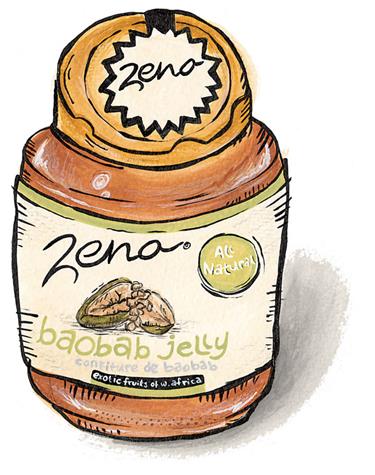Baobab (bay-oh-bab) trees are fairly famous for their giant, bottle-shaped trunks and their odd, spindly branches that look like roots. They look like a tree turned upside down. But baobab fruit is almost unknown. It’s a pity. The fruit is incredible—healthy, with bright, sweet-tart flavor. It makes for amazing jelly.
Baobabs trees are found across Africa from Madagascar to Senegal.
They’re native to the African savannah, where they can grow up to 100 feet tall and more than 150 feet in circumference. They thrive in dry climates because they’re succulents. A single baobab tree can store more than 30,000 gallons of water in its trunk. That helps the trees live for millennia—up to 5,000 years. During droughts they can be valuable sources of water for people, too. Water isn’t the only thing they offer, though. The bark is used for rope and clothing. The seeds are used in cosmetics. The leaves can be eaten. And the fruit is super nutritious. The bounty of resources the trees provide have earned them the nickname “the tree of life.”
When a baobab tree is about twenty years old, it begins producing flowers. In the early summer, white, fluffy blossoms nearly five inches in diameter bloom on skinny stalks up to a yard long that hang down from the branches. That might sound pretty, but looks can be deceiving—it doesn’t smell so great. The aroma is something like carrion, so most people don’t like it. But bats love it. The flowers bloom at night. Bats come to feast on the nectar and, in the process, pollinate the flowers. After pollination, it takes about six months to grow a mature baobab fruit.
What’s a baobab fruit, and what do you do with it?
Baobab fruits are shaped like an oblong cantaloupe. They’re covered in thick, hard shells like coconuts, only instead of having shaggy brown fibers they’re blanketed in a thin, sage-green fuzz. When you shake a baobab fruit, it sounds like it’s filled with sand. After you crack it open with a mallet or by throwing it against a hard floor, the hard rind splits to reveal a clump of spindly orange fibers holding onto dozens of lumps of white, chalky fruit that look something like misshapen marshmallows. The white lumps are the flesh of the fruit, and each one contains a seed. Unlike most fruit though, it’s not juicy. The lumps are dry and powdery, with a sweet-tart flavor that is hard to place—a little reminiscent of grapefruit or strawberry. School kids across central and southern Africa pop those fruits in their mouths and suck on them like candy for a sweet treat.
Across Africa, the fruit is mixed with water and sometimes a little sugar to make a drink like lemonade. It’s mixed into sauces and porridges. The seeds can be cracked open to find a nutty interior, or they can be roasted, ground, and made into a coffee-like drink. And abroad, UK-based distiller Whitley Neill includes baobab fruit as one of the “botanicals” in their gin.
For my part, though, I think the best way to taste baobab fruit is in the jelly made by Zena Exotic Fruits in Senegal. Starting with fruit from local farmers, the jam makers begin by further drying the fruit in the sun to concentrate the sweetness. Then they macerate it with a bit of water, sugar, and just a smidge of pectin before cooking it down. When it’s ready, it has a glossy, peachy color, like a rosy apricot jam.
The finished jelly eats more like a lemon curd than a regular fruit jelly: it’s thick and rich, yet refreshing.The flavor reminds me of orange sherbet—bright, a bit tart, creamy with a vanilla sweetness. But it’s the texture that blows me away—silky smooth, thick like custard. I could eat it by the spoonful… or maybe better yet, spread a thick layer in a pre-baked pie crust or atop a good shortbread cookie for an instant custardy dessert.
8 ways to use baobab jelly this week:
1. Spread it on toast, pancakes, or crepes
2. Swirl it into yogurt
3. Add a dollop to oatmeal or granola
4. Warm it up and drizzle it over ice cream
5. Slather some between the layers of a cake
6. Pair it with a slightly sweet cheese, like gouda or challerhocker
7. Glaze a pork chop with it
8. Make an exotic, creamy PB&B sandwich

